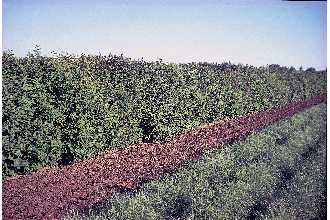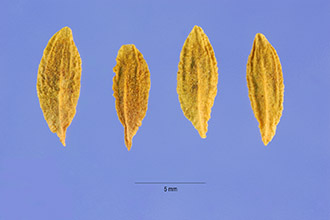Villous Lilac
Scientific Name: Syringa villosa Vahl

| General Information | |
|---|---|
| Usda Symbol | SYVI3 |
| Group | Dicot |
| Life Cycle | Perennial |
| Growth Habits | Shrub |
| Native Locations | SYVI3 |
Plant Guide
Alternate Names
Common Alternate Names: Villous lilac Scientific Alternate Names: None
Uses
Conservation: Late lilac is recommended for windbreak plantings in fields and farmsteads. The dense growth habit is well suited for providing wind and snow protection. Wildlife and Recreation: It provides escape cover and habitat for songbirds and various small mammals. Lilac species are rated excellent for pollen availability when bees first emerge in the spring (Henderson, 1987). The attractive whitish, lavender, or rose-colored blooms add beauty to recreational plantings. Ethnobotany: Medicinal use included a tonic made from leaves and fruit used for the treatment of sore throats. Extracts from Syringa species are known to be toxic to various insect pests (Herman et al., 1996).
Status
Consult the PLANTS Web site and your State Department of Natural Resources for this plants current status (e.g., threatened or endangered species, state noxious status, and wetland indicator values).
Weediness
This plant may become weedy or invasive in some regions or habitats and may displace desirable vegetation if not properly managed, It does not sucker extensively and its fruit is not desired by birds so the degree of spread is generally not a problem, Use soil moisture sensors to measure the soil moisture of Villous Lilac., Please consult with your local NRCS Field Office, Cooperative Extension Service Office, state natural resource, or state agriculture department regarding its status and use, Weed information is also available from the PLANTS Web site at http://plants,usda,gov/, Please consult the Related Web Sites on the Plant Profile for this species for further information,
Description
Late lilac is native to northern China and is a medium to large, hardy shrub with stout spreading branches. It has an oval to irregularly shaped crown. Flowers are white, or rose to pale lavender. It generally flowers 1- 2 weeks “later” than common lilac, and the color fades quickly (Eisel, 1997). Spreading branches sprout from the base. Plants of this species were 10 feet tall and 12 feet wide after 14 years on loam soils in Conservation Tree and Shrub Group 3 in central South Dakota (Knudson, 2004). This species will coppice back after a light fire or mowing. It is long-lived. The brown buds are opposite. Buds are ⅛ to ½ inch long. The entire leaves are simple and broad-elliptic to oblong. The surface is usually pubescent near the midrib and wrinkled. Margins are entire. The large and deep-veined green leaves are 3 to 7 inches long and 1½ inches to 4 inches wide. The flowers which are not as fragrant as common lilac, are borne in large terminal panicles. White to lavender flowers form woody capsules with smooth, brown seeds (Herman et al., 1996). There are 41,000 seeds per pound (Knudson, 2000). The growth habit is upright with a rounded to oval profile. It has a coarse summer and winter texture. The young bark is green-brown, and older bark is gray-brown. Late lilac has a dense, fibrous and shallow root system. It does not form suckers (Herman et al., 1996). The coarse leaves and short-lived flowers are undesirable for landscaping. This is not a good landscape plant because it lacks other good ornamental characteristics (Knowles, 1995).
Distribution
For current distribution, please consult the Plant Profile page for this species on the PLANTS Web site.
Adaptation
Late lilac is hardy to Zone 2. This plant grows best on loams, silt loams, and silty clay loams in the 14–30 inch precipitation zone. It is not as drought tolerant as common lilac in North Dakota. It is recommended in the NRCS Conservation Tree and Shrub Groups 2-4. It is not recommended for droughty or saline soils (Knudson, 2000). Plants growing in heavy sod will have fewer and poorer quality blossoms (Ball et al., 2000).
Management
Conservation grade seedlings are usually 2 years old and 1 to 3 feet tall. Late lilac is a tall shrub that should be planted in the spring 3 to 5 feet apart. Seedlings grow medium fast. Weed control improves survival and growth rates. Dry conditions will cause die-back. Pruning should be done after flowering. Cutting off decadent top growth (coppice) can rejuvenate old or damaged plantings.
Pests and Potential Problems
Unlike most lilacs, late lilac is more resistant to powdery mildew (Blumeria graminis) in years of higher rainfall and in areas of higher precipitation. It may be attacked by the lilac borer (Podosesia syvingae) which is a wasplike moth. Larvae tunnel into main stems and cause loss of vigor and death. Heavily infested stems should be pruned out. Other potential disease pests include several types of leaf spots and blights; other insect pests include caterpillars, scales and leaf miners (Herman et al., 1996; Ball et al., 2000).
Environmental Concerns
Concerns
Concerns
Late lilac is a plant introduced to the United States from northern China. Seed ripens in a capsule not desired by birds. It has basal sprouts, but does not spread by suckers. It is not known to spread aggressively. It may spread by seed locally, but is generally not a problem.
Seeds and Plant Production
Plant Production
Plant Production
Seed ripens in a capsule by late summer and is ready to harvest in mid to late September. It should be air-dried for several weeks. Seed can be cleaned using a hammer mill and fanning mill. It requires a cold, moist stratification of 45-60 days for spring planting. Late lilac can be fall planted without stratification. Plants reach harvestable height after two growing seasons (Knudson, 2000). Cultivars, Improved, and Selected Materials (and area of origin) ‘Legacy’ a seed propagated cultivar released by the USDA NRCS Plant Materials Program from Bismarck, North Dakota. It is recommended for field windbreaks, farmstead windbreaks, wildlife habitat plantings, and recreational plantings in the Great Plains. It does not differ significantly from the description for the species.
References
Ball J., D. Graper, C. Wake. 2000. Shrubs for South Dakota. South Dakota State University: South Dakota Cooperative Extension Service EC 904. Eisel, M. 1997. Trees, shrubs, and vines for Minnesota landscapes. University of Minnesota Extension WW-00545, St. Paul, Minnesota. Henderson, C. 1987. Landscaping for wildlife. Minnesota Dept. of Natural Resources. Minnesota’s Bookstore, St. Paul, Minnesota. Herman, D.E., C. Stange, V. Quam. 1996. North Dakota tree handbook. USDA NRCS; ND State Soil Conservation Committee; NDSU Extension and Western Area Power Admin., Bismarck, North Dakota. Knowles H., 1996. Woody ornamentals for the prairies. University of Alberta, Faculty of Extension, Edmonton, Alberta, Canada. Knudson M., 2000. Legacy late lilac release brochure. USDA NRCS Plant Materials Center, Bismarck, North Dakota. Knudson, M. 2004. Twenty-five years of tree planting trials at the Highmore field evaluation planting. Tech. Rep., USDA NRCS Plant Materials Center, Bismarck, North Dakota. Prepared By: Dwight A. Tober (retired) USDA NRCS, Plant Materials Center, Bismarck, North Dakota Citation Tober, D. 2013. Plant guide for late lilac (Syringa villosa). USDA-Natural Resources Conservation Service, Plant Materials Center, Bismarck, ND. Published June 2013 For more information about this and other plants, please contact your local NRCS field office or
Plant Traits
Growth Requirements
| Temperature, Minimum (°F) | -38 |
|---|---|
| Adapted to Coarse Textured Soils | Yes |
| Adapted to Fine Textured Soils | Yes |
| Adapted to Medium Textured Soils | Yes |
| Anaerobic Tolerance | None |
| CaCO3 Tolerance | Medium |
| Cold Stratification Required | Yes |
| Drought Tolerance | Medium |
| Fertility Requirement | Medium |
| Fire Tolerance | High |
| Frost Free Days, Minimum | 120 |
| Hedge Tolerance | Medium |
| Moisture Use | Medium |
| pH, Maximum | 7.5 |
| pH, Minimum | 5.3 |
| Planting Density per Acre, Maxim | 2700 |
| Planting Density per Acre, Minim | 600 |
| Precipitation, Maximum | 50 |
| Precipitation, Minimum | 24 |
| Root Depth, Minimum (inches) | 14 |
| Salinity Tolerance | None |
| Shade Tolerance | Intolerant |
Morphology/Physiology
| Bloat | None |
|---|---|
| Toxicity | None |
| Resprout Ability | Yes |
| Shape and Orientation | Erect |
| Active Growth Period | Spring and Summer |
| Coppice Potential | Yes |
| Fall Conspicuous | No |
| Fire Resistant | No |
| Flower Color | Purple |
| Flower Conspicuous | Yes |
| Foliage Color | Green |
| Foliage Porosity Summer | Dense |
| Foliage Porosity Winter | Moderate |
| Foliage Texture | Medium |
| Fruit/Seed Conspicuous | No |
| Nitrogen Fixation | None |
| Low Growing Grass | No |
| Lifespan | Moderate |
| Leaf Retention | No |
| Known Allelopath | No |
| Height, Mature (feet) | 10.0 |
| Height at 20 Years, Maximum (fee | 10 |
| Growth Rate | Moderate |
| Growth Form | Multiple Stem |
| Fruit/Seed Color | Brown |
Reproduction
| Vegetative Spread Rate | Slow |
|---|---|
| Small Grain | No |
| Seedling Vigor | Low |
| Seed Spread Rate | Slow |
| Seed per Pound | 142200 |
| Fruit/Seed Persistence | Yes |
| Propagated by Tubers | No |
| Propagated by Sprigs | No |
| Propagated by Sod | No |
| Propagated by Seed | Yes |
| Propagated by Corm | No |
| Propagated by Container | Yes |
| Propagated by Bulb | No |
| Propagated by Bare Root | Yes |
| Fruit/Seed Period End | Fall |
| Fruit/Seed Period Begin | Summer |
| Fruit/Seed Abundance | Medium |
| Commercial Availability | Routinely Available |
| Bloom Period | Late Spring |
| Propagated by Cuttings | No |
Suitability/Use
| Veneer Product | No |
|---|---|
| Pulpwood Product | No |
| Protein Potential | Low |
| Post Product | No |
| Palatable Human | No |
| Palatable Graze Animal | Low |
| Palatable Browse Animal | Low |
| Nursery Stock Product | Yes |
| Naval Store Product | No |
| Lumber Product | No |
| Fodder Product | No |
| Christmas Tree Product | No |
| Berry/Nut/Seed Product | No |

